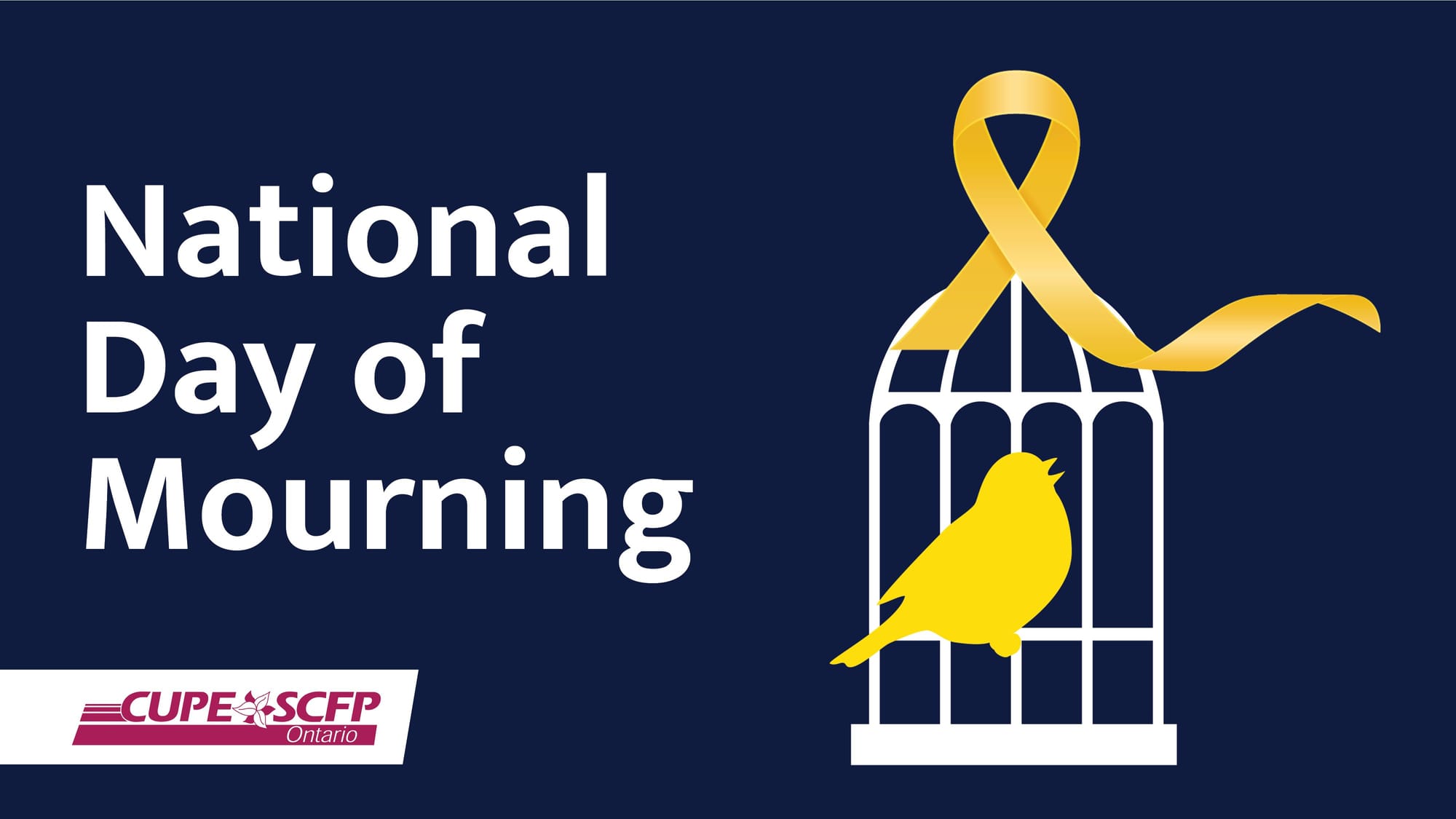
Today is the National Day of Mourning, the annual memorial for workers killed or injured on the job. It’s a day to mourn workers who have lost their lives, but also to renew the fight for safe and healthy workplaces, because a single death at work is one too many.
The idea to designate a day to mourn and honour those killed at work in Canada was proposed by two union activists, Colin Lambert and Ray Sentes, in the 1980s. After seeing public remembrances for police and firefighters killed in the line of duty, Lambert and Sentes thought workers killed on the job deserved the same level of respect. They also drew inspiration from United Steelworkers members in Elliot Lake, Ont., who held annual remembrance days for uranium miners who died from occupational diseases. In 1984, the Canadian Union of Public Employees passed a convention resolution to extend this practice and observe a National Day of Mourning. The Canadian Labour Congress did the same in 1986, and along with federations of labour and labour councils across the country, continues to organize commemorative vigils and events every year.
Responding to the labour movement’s initiatives, Parliament passed a Workers Mourning Day Act in 1991, marking April 28 a national day of observance. Today, governments, unions and workers in more than 100 countries commemorate fallen workers at similar annual events.
While a solemn day to honour fallen workers, the Day of Mourning is also a time to reaffirm our commitment to workplace health and safety.
Part of this renewal involves a sober assessment of the shortcomings of Canada’s occupational health and safety law and policy. While officially counted workplace deaths and injury rates have trended downward somewhat in recent years, it nevertheless remains the case that many workers suffer the ultimate fate while simply trying to earn a living.
According to the Association of Workers’ Compensation Boards of Canada (AWCBC), 993 workers died because of something work-related in 2022 (the latest available data). That’s hundreds of workers who went to work and never returned home and hundreds of families who lost loved ones.
It’s important to keep in mind, as well, that these data represent only deaths officially recognized as “work-related.” Some research estimates that work-related deaths are 10 times higher than those accepted by workers’ compensation boards. The same goes for workplace injuries, which are under-counted to an even greater extent.
The AWCBC, the national body that collects workplace injury and fatality data, reports that construction, manufacturing, and agriculture, forestry, fishing, and hunting remain the most fatal industries in Canada, accounting for 467, or nearly half of workplace deaths. At the same time, work-related fatalities occurred in almost all industrial groups, including 103 in public administration. In other words, workers face grave workplace risks across the entire economy.
As might be expected, workplace fatalities frequently involve vehicular accidents, dangerous equipment or working at heights. Indeed, in 2022, transportation accidents, contact with objects and equipment, and falls accounted for 119, 80, and 75 worker deaths, respectively. Also troubling are the 14 workers whose deaths involved assaults, violent acts, attacks or harassment on the job — a statistic that should be borne in mind as healthcare workers, particularly nurses, experience increasing levels of violence.
What is most shocking, however, is the number of workers who die of occupational diseases. In 2022, 626 workers perished from exposure to harmful substances or environments, accounting for 63 per cent of all work-related fatalities.
Although event-based fatalities, such as falls or explosions, tend to be more headline-grabbing, the primary killers at work are harmful chemicals and other dangerous substances. As Bob Barnetson argues, in many respects employers treat workers like lab rats by exposing them to toxic or otherwise harmful substances on the job. Despite the “right to know” about workplace risks constituting a central pillar of Occupational Health and Safety Act (OHS) law, the full extent of exposure risk is often unknown or underestimated. For example, “threshold limit values,” (i.e., the regulations that determine ostensibly safe levels of exposure for various substances), tend to be lowered over time, indicating they were set too high to begin with.
Canada is no outlier when it comes to our share of occupational disease-related fatalities. The International Labour Organisation (ILO), for example, reports that 2.6 million workplace deaths worldwide were attributable to work-related diseases in 2019, while occupational “accidents” accounted for 330,000 deaths. In the Global South, however, exposure to long working hours remains a primary killer, a risk not unrelated to other forms of harmful exposure.
In Canada, while workers 65 and over accounted for the majority of deaths in 2022 — mostly due to these various occupational diseases — there were also 33 workers aged 15 to 24 who were killed at or because of work. Young workers tend to experience higher levels of workplace risk and injury, in part due to inexperience, but also because they may be less likely to know or assert their rights on the job.
To take a recent example, Wil Krotenko, 14, suffered severe carbon monoxide poisoning and nearly died after his manager directed him to operate a gas-powered pressure washer in an enclosed area at a Co-op grocery store in Canora, Sask.
What punishment did the grocery store receive for exposing this teenager to carbon monoxide at levels up to 60 times higher than the province’s OHS regulations stipulate as safe? Co-op received no monetary fine or punishment and, according to the CBC, was simply told to “fix the problems.”
Krotenko’s case highlights a glaring and persistent problem with occupational health and safety in Canada: the lack of meaningful deterrence and punishments for employers who break the law and kill or injure workers.
Some provincial workplace safety and health branches can issue fines and other monetary penalties, but not all. In the jurisdictions that do issue monetary fines, their value tends to be relatively low. For example, in Manitoba, administrative penalties are typically $2,500 or $5,000.
Labour inspectorates can also pursue prosecutions through the courts, but these are rare. Even when convictions involve heavier fines, the sums still reflect a desire to not ‘overburden’ business. In Manitoba, the largest fine last year was issued to Manitoba Hydro: a $65,000 penalty after a worker was electrocuted and suffered second-degree burns on the face.
Cases where workers died don’t appreciably change the dynamic. In Nova Scotia, the Brick was recently fined nearly $144,000 after a worker fractured his skull during a fall on the job and died. Understandably, this paltry sum did little to comfort the worker’s family.
Compounding the problem, labour inspectorates tasked with enforcing OHS regulations are spread extremely thin. A lack of resources and personnel means that governments are highly dependent on workers, unions, and employers to self-regulate through the “internal responsibility system” (IRS). Workplaces with 20 or more employees are legislatively required to have a labour-management health and safety committee that meets regularly, though in practice workers without a union often have difficulty enforcing their health and safety rights. As well, with the growth of precarious employment and small firms, many workers are shut out of the IRS altogether.
Perhaps most disappointing has been the lack of successful criminal convictions for employers whose negligence causes death on the job.
After the Westray mine disaster in 1992, the Canadian labour movement waged a more-than-decade-long battle to win the ability to prosecute corporations and senior executives whose actions kill workers. In 2004, the Westray Bill amended the Criminal Code to allow for maximum punishments of 10 years in prison for individuals whose negligence causes serious injury, and life in prison for negligence causing death. As a result of the law, corporations can now be put on probation and carry criminal records. Whether an individual or a corporation, unlimited fines may be imposed, with an additional 30 per cent victim surcharge.
Without question, the Westray Bill was a significant labour victory. In the years since, however, prosecutions under the law have been underwhelming, to say the least. To date, there have only been nine successful prosecutions under the law — seven companies and two individuals. In a number of cases, the law has been applied against small companies, not the large corporations many in labour had hoped to hold to account. In only one case has a manager served prison time, and the largest fine ever imposed was $1.4 million.
The United Steelworkers, a union instrumental in winning the Westray reform, recently referred to “two decades of failure to hold employers accountable for thousands of workplace deaths and injuries.” Their summary is apt.
Reforming our system of health and safety regulation and punishment is paramount. Governments need to prioritize deterrence. At present, penalties are little more than a cost of doing business and do not meaningfully protect workers. We have the ability to criminally prosecute employers who kill workers, but that capacity too often lies dormant. A system that protects ‘business confidence’ more than workers’ lives is in deep need of an overhaul.
It’s common to refer to workplace deaths as “accidents.” But when it comes to death on the job, there are no accidents. People are at work because it’s the only way they can put food on the table and keep a roof over their heads. Bosses set the conditions of work, so it’s their responsibility to keep workers safe. When they don’t, punishment is due and it should fit the crime.
There’s a long way to go before we reach the appropriate numbers of workplace deaths in Canada: zero.
For today: mourn the death, and fight for the living.
CORRECTION: This newsletter has been updated to correct some dates in the timeline of the formation of the National Day of Mourning. The Maple regrets these errors.
Recent Class Struggle Issues
- April 22 | Reviewing The State Of The Labour Market – March 2024
- April 17 | Debunking The Latest Pro-Scab National Post Article
- April 8 | Pay Transparency Is A Collective Win For Workers
- March 25 | The U.S. Is Witnessing A Considerable Growth In Strike Activity







